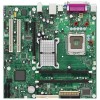Intel BLKD946GZABL Product Specification - Page 22
Dynamic Video Memory Technology DVMT
 |
View all Intel BLKD946GZABL manuals
Add to My Manuals
Save this manual to your list of manuals |
Page 22 highlights
Intel Desktop Board D946GZAB Technical Product Specification • 2D Graphics enhancements ⎯ 8, 16, and 32 bit color ⎯ Optimized 256-bit BLT engine ⎯ Color space conversion ⎯ Anti-aliased lines • Video ⎯ Hardware motion compensation and iDCT for MPEG2 ⎯ Software DVD at 30 fps full screen • Display ⎯ Integrated 24-bit 400 MHz RAMDAC ⎯ Up to 2048 x 1536 at 75 Hz refresh (QXGA) ⎯ DDC2B compliant interface with Advanced Digital Display 2 or 2+ card (ADD2/ADD2+), support for TV-out/TV-in and DVI digital display connections ⎯ Supports flat panels up to 2048 x 1536 at 75 Hz (when in dual-channel mode) or digital CRT/HDTV at 1920 x 1080 at 85 Hz (with ADD2/MEC) ⎯ Two multiplexed SDVO port interfaces with 270 MHz pixel clocks using an ADD2/MEC card • Dynamic Video Memory Technology (DVMT) support up to 256 MB • Intel® Zoom Utility 1.5.1.2 Dynamic Video Memory Technology (DVMT) DVMT enables enhanced graphics and memory performance through highly efficient memory utilization. DVMT ensures the most efficient use of available system memory for maximum 2-D/3-D graphics performance. Up to 256 MB of system memory can be allocated to DVMT on systems that have 512 MB or more of total system memory installed. Up to 128 MB can be allocated to DVMT on systems that have 256 MB but less than 512 MB of total installed system memory. Up to 64 MB can be allocated to DVMT when less than 256 MB of system memory is installed. DVMT returns system memory back to the operating system when the additional system memory is no longer required by the graphics subsystem. DVMT will always use a minimal fixed portion of system physical memory (as set in the BIOS Setup program) for compatibility with legacy applications. An example of this would be when using VGA graphics under DOS. Once loaded, the operating system and graphics drivers allocate additional system memory to the graphics buffer as needed for performing graphics functions. NOTE The use of DVMT requires operating system driver support. 22















